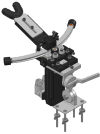Automated head motion system improves reliability and lessens operator dependence for head impulse testing of vestibular reflexes
- PMID: 30221255
- PMCID: PMC6136842
- DOI: 10.1109/MeMeA.2017.7985856
Automated head motion system improves reliability and lessens operator dependence for head impulse testing of vestibular reflexes
Abstract
Deficiency of the eye-stabilizing vestibulo-ocular reflex (VOR) is a defining feature in multiple diseases of the vestibular labyrinth, which comprises the inner ear's sensors of head rotation, translation and orientation. Diagnosis of these disorders is facilitated by observation and measurement of eye movements during and after head motion. The video head impulse test has recently garnered interest as a clinical diagnostic assessment of vestibular dysfunction. In typical practice, it involves use of video-oculography goggles to measure eye movements while a clinician examiner grasps the subject's head and manually rotates it left or right at sufficient acceleration to cover ~20 deg over ~150 mS, reaching a peak velocity of >120 deg/S midway through the movement. Manual delivery of head impulses incurs significant trial-by-trial, inter-session and inter-operator variability, which lessens the test's reliability, efficiency, safety and standardization across testing facilities. We describe application of a novel, compact and portable automated head impulse test (aHIT™) device that delivers highly repeatable head motion stimuli about axes parallel to those of the vestibular labyrinth's six semicircular canals, with programmable Gaussian and sinusoidal motion profiles at amplitudes, velocities and accelerations sufficient to test VOR function over the spectral range for which the VOR dominates other vision-stabilizing reflexes. We tested the aHIT™ on human subjects and demonstrated its high reproducibility compared to manually delivered head impulses. This device has the potential to be a valuable clinical and research tool for diagnostic evaluation and investigation of the vestibular system.
Keywords: aHIT; automated head impulse test; head impulse test; vestibular system; vestibulo-ocular reflex.
Figures




Similar articles
-
Normative data and test-retest reliability of the SYNAPSYS video head impulse test.J Am Acad Audiol. 2014 Mar;25(3):244-52. doi: 10.3766/jaaa.25.3.3. J Am Acad Audiol. 2014. PMID: 25032968
-
The Video Head Impulse Test (vHIT) of Semicircular Canal Function - Age-Dependent Normative Values of VOR Gain in Healthy Subjects.Front Neurol. 2015 Jul 8;6:154. doi: 10.3389/fneur.2015.00154. eCollection 2015. Front Neurol. 2015. PMID: 26217301 Free PMC article.
-
A video-oculographic study of acute vestibular syndromes.Acta Neurol Scand. 2016 Oct;134(4):258-64. doi: 10.1111/ane.12536. Epub 2015 Nov 26. Acta Neurol Scand. 2016. PMID: 26608951
-
Rotational testing.Handb Clin Neurol. 2016;137:177-86. doi: 10.1016/B978-0-444-63437-5.00012-1. Handb Clin Neurol. 2016. PMID: 27638070 Review.
-
Impulsive testing of semicircular-canal function using video-oculography.Ann N Y Acad Sci. 2009 May;1164:486-91. doi: 10.1111/j.1749-6632.2008.03730.x. Ann N Y Acad Sci. 2009. PMID: 19645955 Review.
Cited by
-
Quantifying a Learning Curve for Video Head Impulse Test: Pitfalls and Pearls.Front Neurol. 2021 Jan 22;11:615651. doi: 10.3389/fneur.2020.615651. eCollection 2020. Front Neurol. 2021. PMID: 33551973 Free PMC article.
-
A New Suppression Index Calculation Using the Visually Enhanced Vestibulo-Ocular Reflex and Vestibulo-Ocular Reflex Suppression Paradigms in the Video Head Impulse Test.Audiol Res. 2024 Aug 22;14(4):747-759. doi: 10.3390/audiolres14040063. Audiol Res. 2024. PMID: 39194419 Free PMC article.
-
Continuous vestibular implant stimulation partially restores eye-stabilizing reflexes.JCI Insight. 2019 Nov 14;4(22):e128397. doi: 10.1172/jci.insight.128397. JCI Insight. 2019. PMID: 31723056 Free PMC article. Clinical Trial.
References
-
- Lysakowski A. Anatomy of the Vestibular System. In: Flint P, Cummings C, editors. Cummings Otolaryngology - Head and Neck Surgery. 5th. Philadelphia, PA: Mosby/Elsevier; 2010. pp. 1850–1865.
-
- Carey JP, Della Santina CC. Principles of Applied Vestibular Physiology. In: Flint P, Cummings C, editors. Cummings Otolaryngology - Head and Neck Surgery. 5th. Philadelphia, PA: Mosby/Elsevier; 2010. pp. 2276–2304.
-
- Crane BT, Schessel DA, Nedzelski J, Minor LB. Peripheral Vestibular Disorders. In: Flint P, Cummings C, editors. Cummings Otolaryngology - Head and Neck Surgery. 5th. Philadelphia, PA: Mosby/Elsevier; 2010. pp. 2328–2345.
-
- Halmagyi GM, Curthoys IS. A clinical sign of canal Paresis. Archives of Neurology. 1988 Jul;45(7):737–739. - PubMed
-
- Halmagyi GM, Aw ST, Cremer PD, Curthoys IS, Todd MJ. Impulsive testing of individual semicircular canal function. Annals of the New York Academy of Sciences. 2006 Jan;942(1):192–200. - PubMed
Grants and funding
LinkOut - more resources
Full Text Sources
Other Literature Sources
